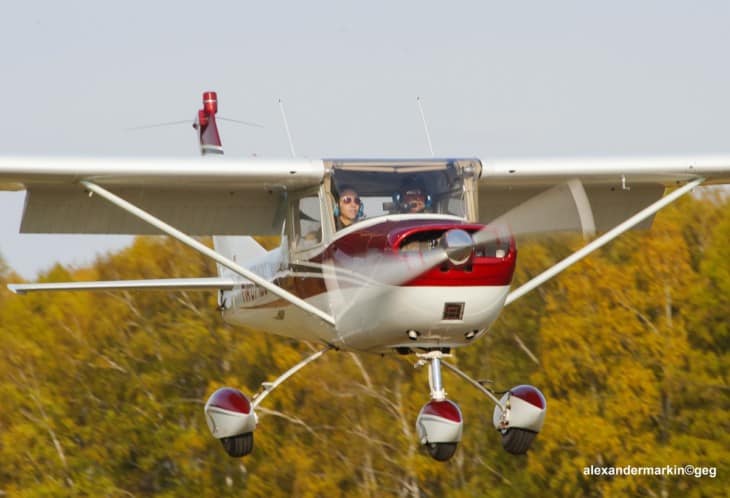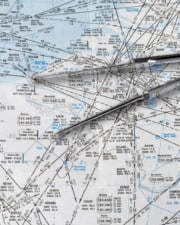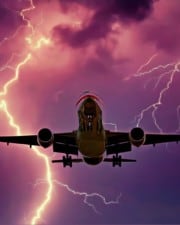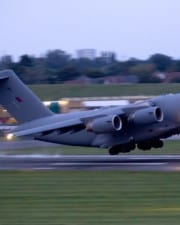Pilot training and testing are unlike the exams most people remember from school. The closest experience most people have is when they get their driver’s license. To get your driver’s license, you usually have to sit for a multiple-choice written exam and then get in the car with an examiner and drive around the neighborhood. In the pilot world, we’d call that quick drive around the block a “checkride.”
Table of Contents
Technically, a checkride is pilot slang for the FAA Practical Exam. The Practical Exam is a two-part test, given by an FAA Safety Inspector or a Designated Pilot Examiner, to an applicant for an airman certificate. There is an oral exam followed by a flight in the aircraft. The checkride is the final step in a long process of training — a pass from the examiner means that you walk out of the building a full-fledged pilot.
What is a Checkride?
A checkride is the last step that a student pilot takes before receiving their pilot’s license. For all pilots, checkride day is a big one, full of anxiety and hopefully joy at the big reward at the end.
The PPL checkride (private pilot) is just the first of many that a pilot will take over the course of their career. Anytime a pilot wants to add new priveledges to their pilot certificate, they’ll need to pass a checkride. Here are some of the checkrides a typical pilot might take during their career.
- Private pilot certificate
- Instrument rating
- Commercial pilot certificate
- Multi-engine rating
- Airline transport pilot (ATP) certificate
- Type ratings for specific aircraft (i.e., B737, A320, etc.)
Flight checks are also required for professional pilots who work for commercial operators, like airlines or charter companies. For example, pilots employed by a Part 135 charter company must complete a “299 ride” every year. The 299 is a checkride required by Federal Aviation Regulation 135.299.
What is a Mock Checkride?
You’ll often hear instructors and students talking about “mock checkrides.” These are regular flight lessons, but they serve as rehearsals for the student’s real FAA checkride.
Most students will do three or more mock checkrides during their training. Instructors want to make sure the students have learned all of the important maneuvers and will have no problems on the actual checkride.
Mock checkrides are a normal part of flight training. The goal is to relieve the student’s stress when checkride day comes around–there should be no surprises. Since they’ve done so many mock checkrides and done well with their instructor, the actual checkride should be a piece of cake.
Who Conducts an FAA Checkride?
For some students, the examiner they take their checkride will be the first person they fly with other than their flight instructor. So who are examiners?
Checkrides are usually done by a Designated Pilot Examiner (DPE). As their title suggests, these experienced pilots are “designated” by the FAA to conduct pilot exams on their behalf. They are not government employees—they’re just pilots and certified flight instructors who have the experience and have gone to the effort to make giving pilot exams a career.
If you’re a student at a flight school, the chief instructor might be an FAA DPE. In this case, you might have flown with that person prior, but on checkride day, they will be conducting the checkride precisely as any other DPE would—as an independent third party.
In some cases, you might do a checkride with an FAA Aviation Safety Inspector (ASI). An ASI is a government employee who works at your local FAA Flight Standards District Office (FSDO).
No matter who conducts the actual checkride, it will look more or less identical. The FAA has strict standards that examiners must follow, so regardless of where you do your checkride or who you fly with, you’ll be tested on the same things in much the same ways.
What Does a Checkride Consist Of?
The FAA practical exam always consists of two parts. It begins with an oral exam and is concluded by a practical flight test. Every checkride is described in an FAA document called the ACS—the Airman Certification Standards.
However, the checkride is not the first test a pilot must take to get their license. Before being eligible for the practical test, a pilot must sit for the knowledge exam. The knowledge exam is commonly called the written test, and it usually consists of 60 multiple-choice questions.
As one small part of the oral exam, the examiner will look at your knowledge exam and quiz you on those topics you missed. The results from your knowledge exam are telling for the examiner. They’re going to notice if you scored well or barely scraped by. Passing on the knowledge exam means scoring 70% or higher, and if you scored in the 70-percentile, you could expect some extra tough questions during the oral exam.
The oral will cover the many topic areas in the ACS that pertain to the license you’re applying for. For example, the Private Pilot-Airplane ACS spells out the following knowledge areas.
- Federal Aviation Regulations (FARs) about pilots and aircraft
- Weather information
- Cross-country flight planning
- National Airspace System (NAS)
- Aircraft performance and limitations
- Operation of aircraft systems
- Human factors
What Happens on a Checkride?
Upon successfully completing the oral exam, the student pilot will be released to prepare for the flight. However, the oral portion of the exam is never officially over—many examiners may ask questions as you prepare and pre-flight the aircraft.
In the air, the examiner will walk the student through the maneuvers and scenarios spelled out in the ACS. There’s no set order of events, and where you fly and how long you fly are at the examiner’s discretion. A typical flight is usually conducted as follows.
- Pre-flight the aircraft, start-up, and taxi for departure
- Depart the airport on a mock cross-country flight, as discussed prior during the oral portion of the exam
- As so point during early-on in the cross-country, the examiner will have you divert to a nearby airport
- You may land at that airport, and many examiners use this as an opportunity to practice a simulated emergency
- You’ll depart the airport and work your way back to your home airport
- Along the way, you’ll conduct any remaining maneuvers from the ACS
- When you get back to the airport, you will likely do two or three more landings and flights around the traffic pattern.
For the precise details on precisely what a specific checkride entails, pilots and examiners refer to the Airman Certification Standards (ACS) document. There’s an ACS published for every certificate and rating that a pilot could apply for. Using the included tables, you can determine which tasks you’ll have to do on the check ride and which ones don’t apply to you.
How Hard is a Checkride?
So, now you know what goes on during a practical test, but you might still be wondering how hard it is. The answer depends on a lot of factors—it’s one of the impossible questions to answer unequivocally.
The best advice any flight instructor can give you is to trust the system. From the first flight you took, your entire course was designed with the checkride in mind. As complicated as the ACS makes it all sound, a checkride is just an independent pilot flying with you to make sure you meet the minimum standards of being a safe pilot.
Another way to look at it is this—the checkride is quite easy. By the time your flight instructor signs your application form and sends you with the examiner, they know you will pass. All you have to do at that point is prove to the examiner what you’ve already proven to your flight instructor.
But, there’s always a “but”, getting to the point is challenging for the best pilots. Many people spend a year or more getting all of their training completed and practicing their maneuvers sufficiently to prove that they can do it safely and accurately on a checkride.
So the checkride is the easy part. Getting to the point where you’re ready to sit for your checkride is the hard part.
How Long is a Checkride Flight?
The precise length of a checkride flight depends on how many tasks must be completed in the ACS. Most DPEs make their living conducting these exams and know how to get these tasks done in the quickest possible order.
For planning purposes, the private pilot checkride usually requires two hours for the oral exam and then two hours in the plane. Of course, the actual time will be slightly less than this for each of these items, and there will invariably be some time in between as the student gets ready to fly and pre-flights the aircraft.
No matter the certificate or rating you are applying for, most checkride flights come in at around two hours. This is a standard flight block at most schools, fitting nicely with the aircraft rental schedule. It allows enough time to test what needs to be tested, and it also is short enough that students can perform their best without burning out.
In truth, most students find that checkrides fly by. While oral exams may seem to drag on and on, pilots are in their “natural” environments once in the plane and performing maneuvers. It might be a demanding and stressful flight, any exam always is, but the pilot is busy, and the time goes by quickly.
How to Pass a Checkride
Every pilot has their tips and tricks to passing an FAA checkride. There probably isn’t any other topic that will bring out so many superstitions in pilots. Some always fly wearing the same headset, and others only use that one special pen.
But, if you do what your instructor taught you, passing a checkride should never be in doubt. As you have already proven, the knowledge and skills required are in your head. All that remains is checking the right boxes, dotting all the i’s, and crossing the t’s.
With that in mind, here’s a list of things you can do before every checkride to ensure that you’re ready to go and ready to pass.
- Download a copy of the most current ACS for the rating you’re applying for, and read it from front to back. Make sure you understand exactly which tasks you must perform and how well you must perform them.
- Review the FARs for the rating you are applying for line-by-line. Ensure that you have all of those requirements in your logbook. Use removable plastic flags to make those easy to find during the checkride.
- Study for the oral during your own time. Get a copy of the current ASA Oral Exam Guide and have friends quiz you from it. Know the answers to the questions in the book like the back of your hand.
- Go through several mock checkrides with your instructor. This includes oral and practical portions. Then go on a mock checkride with a different instructor. Make sure you’ve practiced every maneuver in the ACS more than once.
- Fill out your IACRA form carefully and thoroughly.
- Dress professionally for your checkride and show up early and prepared.
- Be courteous and professional throughout your checkride.
- Don’t try anything new or different during the checkride. Instead, perform everything precisely as you practiced with your instructor.
Related Posts













